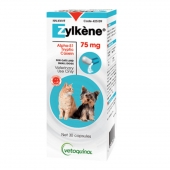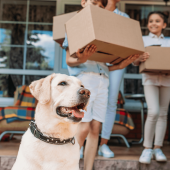Our pets experience stress too
Believe it or not, some situations can create fear or anxiety in our furry friends, just as they can in us! Unfortunately, our pets have no way of telling us what they are feeling! So, instead of worrying yourself into knots trying to interpret their actions or trying to read their minds, we can help you with an explanation of the most common stressful situations in pets.
Being Home Alone
Does your pet seem stressed when you’re away from home? If so, he may show it in various ways. But since it happens when you’re away from home, his stressed condition may be hard to recognize. You may, however, notice excessive vocalization when you leave as well as broken or damaged objects when you come back.
If you have your doubts about his condition, you can always record his behaviour throughout the day when you go out. When you get back, you can watch the video for behaviour that appears abnormal, such as hypersalivation (drooling), trembling, or lowered ears, and show it to your vet for guidance on what to do.
Visits to the Vet
Veterinary visits are often stressful for dogs and cats. If you notice drooling or avoidance in your dog, or excessive vocalization, a puffed-up tail, or dilated pupils in your cat, there’s a good chance they aren’t thrilled about going to the vet!
You can dial back the stress by bringing along something your pet enjoys, like a toy, a treat, or her food. Why not offer a treat while she is getting her shots, this will make the experience a bit more enjoyable!
Being groomed
If your pet struggles, tries to bite, or urinates when being groomed, she clearly doesn’t like it! The best solution is desensitization, or gradually getting your pet used to the handling she dislikes. For example, if a cat hates having her claws trimmed, start by touching her shoulder. When she’s used to this, move down to her elbow, then her claw, and so on. Then during your next visit to the vet’s, ask your veterinary team for advice about getting your pet more used to grooming.
Fireworks and Storms
If you’ve noticed your pet pacing, hiding, or drooling during storms or fireworks, the noise is probably the cause of her stress. She may get used to it over time but if not, desensitization might help. The basic idea is to play recordings of storms or fireworks while she is doing something she enjoys, like eating. Starting with the volume very low, gradually increase it when you see that the sound has no effect on her behaviour. You can find lots of CDs with these kinds of sounds, on internet or at your local music store.
Car rides
There are two main reasons that may explain why your pet doesn’t like riding in the car: motion sickness (in this case, your vet can prescribe medication) or stress. In dogs, the signs may be excessive licking, panting, or pinned ears; in cats, look for dilated pupils, a puffed-up tail, or excessive vocalization.
Once again, the goal is to get your pet used to the experience so that it becomes a positive activity. Start by just coaxing him into the car to get him used to it: do not start the engine. Once he has gotten over that hurdle, reward him. Move on to the next steps until your pet enjoys riding with you! For more information on the step-by-step process, watch our video on travel stress.
Welcoming a New Pet
A new pet in the home is as stressful for the newcomer as it is for the resident pet! If they aren’t introduced gradually, one or the other can be affected in a stressful way. Limiting direct contact between the newcomer and the resident pet is a good idea. For example, you can keep your new pet in one room of the house for a few hours or, even days, so that each one can gradually get used to the other’s presence. In any event, you should talk to your vet to properly prepare for your new friend’s arrival!
A New Baby
The arrival of a new baby and all the changes that it involves can be stressful for your pet. Warning signs to watch for and react to can be a lowered tail, pinned back ears, and excessive licking in dogs. In cats, you may notice an arched back, dilated pupils, or a puffed-up tail. Since you should have nine months to get ready for this happy event, we strongly recommend getting advice from your vet to help make the transition as smooth as possible for your pet!
Having guests over
New faces, noises and laughter can be stressful for your best bud! To find out how to spare your pet needless stress and pick up some helpful tips, watch our video.
If you notice your pet reacting negatively in any situation, you need to talk to your vet: he or she is the one source for advice on keeping your beloved pet calm.



